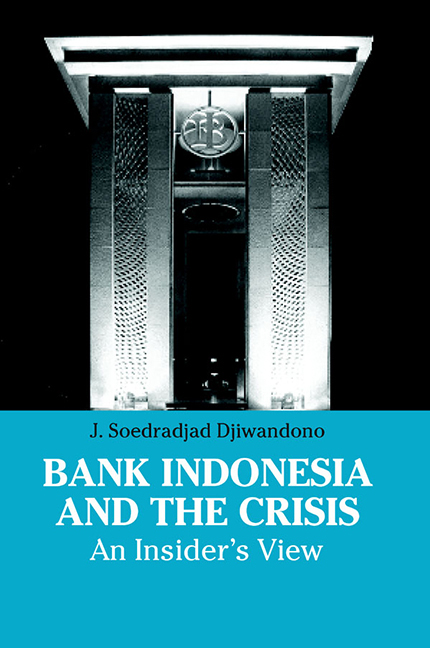Book contents
- Frontmatter
- Dedication
- Contents
- List of Tables
- Acknowledgements
- Glossary
- Prologue: The Crisis and Me
- 1 Introduction
- 2 Origin of the Crisis and Early Responses
- 3 Stabilization and Reform Programmes
- 4 Poor Programme Implementation
- 5 Stronger Programme with Weak Commitment
- 6 Bank Indonesia and the Crisis
- 7 Lessons from the Crisis
- 8 Epilogue
- Postscript
- Notes
- References
- Index
- About the Author
6 - Bank Indonesia and the Crisis
Published online by Cambridge University Press: 21 October 2015
- Frontmatter
- Dedication
- Contents
- List of Tables
- Acknowledgements
- Glossary
- Prologue: The Crisis and Me
- 1 Introduction
- 2 Origin of the Crisis and Early Responses
- 3 Stabilization and Reform Programmes
- 4 Poor Programme Implementation
- 5 Stronger Programme with Weak Commitment
- 6 Bank Indonesia and the Crisis
- 7 Lessons from the Crisis
- 8 Epilogue
- Postscript
- Notes
- References
- Index
- About the Author
Summary
Controversial Issues
Several steps that were taken by the government and the central bank during the crisis have become the subject of public debate in Indonesia and unfortunately have not been resolved to the present. Some policies have even become controversial, due partly to the lack of clarity on the part of many concerning what had been the real issues or the reasoning behind steps taken.
I will discuss three of them, namely the policy of granting liquidity support to banks; the debates on fixing the currency to the dollar in a currency board arrangement; and the issues associated with granting autonomy to the central bank.
My discussions here will not guarantee the disappearance of the controversies if the differences resulted from ideology or vested interests, in particular if “tribalism” is involved (Budiman 1999).
Liquidity Support to Banks
In tandem with the bank closures of November 1997, the most controversial policy launched during the crisis was the liquidity support to banks in distress that Bank Indonesia provided.
Was this a government or a central bank policy? What was the reasoning in either case? How should the losses arising from the liquidity support be apportioned between institutions? Who should be held responsible for the policy and its implications? How did the government deal with the alleged corruption?
The liquidity support to banks that Bank Indonesia provided during the crisis became controversial when the Supreme Audit Board issued two reports on the audits conducted in fulfillment of a request by the Parliament. The first one was a general audit report with a disclaimer, which the Agency issued in November 1999. The issuing of an audit report with a disclaimer is automatically read as a sign of problems in the audited institution, i.e. Bank Indonesia in this case. The second report was on an investigative audit on the central bank due to alleged possible criminal acts of corruption.
- Type
- Chapter
- Information
- Bank Indonesia and the CrisisAn Insider's View, pp. 165 - 217Publisher: ISEAS–Yusof Ishak InstitutePrint publication year: 2005



